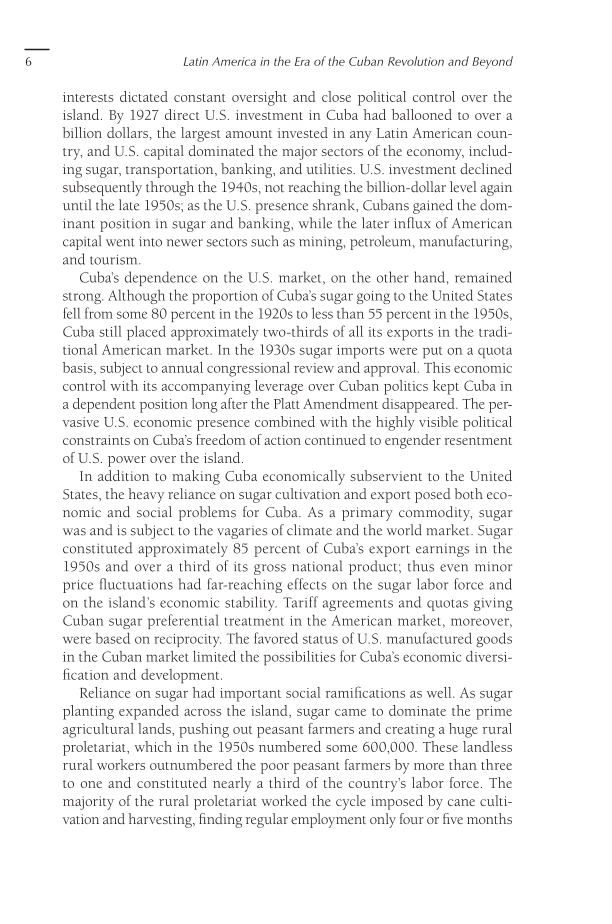6 Latin America in the Era of the Cuban Revolution and Beyond
interests dictated constant oversight and close political control over the
island. By 1927 direct U.S. investment in Cuba had ballooned to over a
billion dollars, the largest amount invested in any Latin American coun-
try, and U.S. capital dominated the major sectors of the economy, includ-
ing sugar, transportation, banking, and utilities. U.S. investment declined
subsequently through the 1940s, not reaching the billion-dollar level again
until the late 1950s; as the U.S. presence shrank, Cubans gained the dom-
inant position in sugar and banking, while the later influx of American
capital went into newer sectors such as mining, petroleum, manufacturing,
and tourism.
Cuba’s dependence on the U.S. market, on the other hand, remained
strong. Although the proportion of Cuba’s sugar going to the United States
fell from some 80 percent in the 1920s to less than 55 percent in the 1950s,
Cuba still placed approximately two-thirds of all its exports in the tradi-
tional American market. In the 1930s sugar imports were put on a quota
basis, subject to annual congressional review and approval. This economic
control with its accompanying leverage over Cuban politics kept Cuba in
a dependent position long after the Platt Amendment disappeared. The per-
vasive U.S. economic presence combined with the highly visible political
constraints on Cuba’s freedom of action continued to engender resentment
of U.S. power over the island.
In addition to making Cuba economically subservient to the United
States, the heavy reliance on sugar cultivation and export posed both eco-
nomic and social problems for Cuba. As a primary commodity, sugar
was and is subject to the vagaries of climate and the world market. Sugar
constituted approximately 85 percent of Cuba’s export earnings in the
1950s and over a third of its gross national product; thus even minor
price fluctuations had far-reaching effects on the sugar labor force and
on the island’s economic stability. Tariff agreements and quotas giving
Cuban sugar preferential treatment in the American market, moreover,
were based on reciprocity. The favored status of U.S. manufactured goods
in the Cuban market limited the possibilities for Cuba’s economic diversi-
fication and development.
Reliance on sugar had important social ramifications as well. As sugar
planting expanded across the island, sugar came to dominate the prime
agricultural lands, pushing out peasant farmers and creating a huge rural
proletariat, which in the 1950s numbered some 600,000. These landless
rural workers outnumbered the poor peasant farmers by more than three
to one and constituted nearly a third of the country’s labor force. The
majority of the rural proletariat worked the cycle imposed by cane culti-
vation and harvesting, finding regular employment only four or five months

























































































































































































































































































































